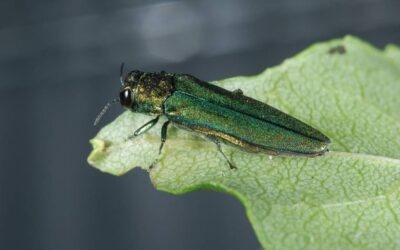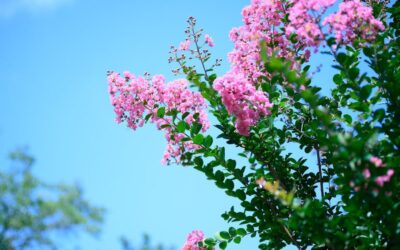Blog Topics
If you notice leaves with lots of tiny yellowish or bleached spots, leaves turning pale bronze, scorching around leaf edges, or leaves falling off prematurely, your plant is probably infested with spider mites. In fact, spider mites are considered the number one pest of ornamental plants in the southeastern United States. Learn what to look for, how to treat affected trees and shrubs, and how to prevent spider mite damage.
Types of Spider Mites in Northern Virginia
Two Spotted Spider Mite (Tetranychus urticae)
- Most active in summer
- Feeds on almost all plants
The most common type of spider mite in our area is the Two Spotted Spider Mite, named for the two dark spots found on each side of its body. It’s most active during summer and feeds on pretty much anything growing in your yard, from weeds to annuals, perennials to vegetables, fruit, and fruit trees. They also love houseplants so if you bring your houseplants outside in the warmer months, check them carefully before bringing them indoors at the end of the season.
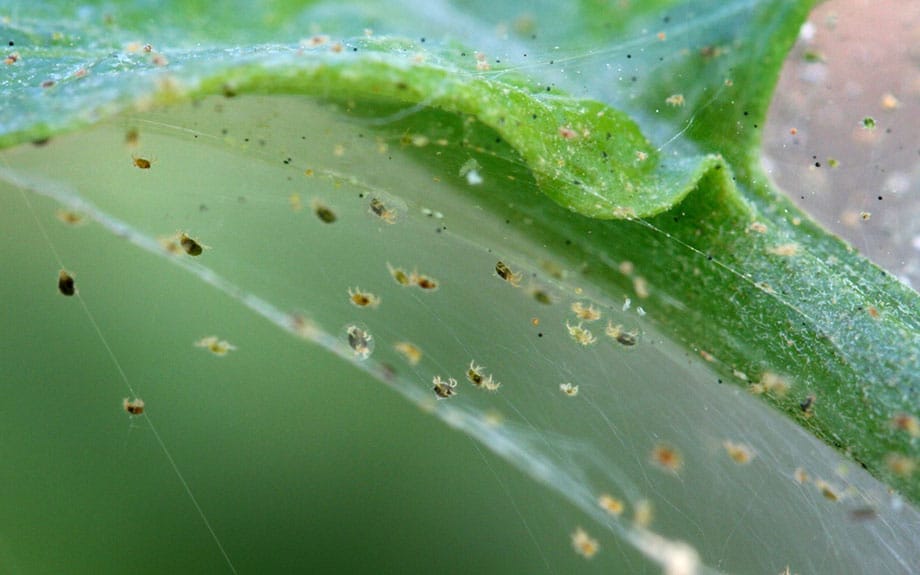
Two-spotted spider mites and webbing
Spruce Spider Mite (Oligonychus ununguis)
- Most active in late spring and fall, damage seen in summer
- Feeds on conifer
Conifers tend to be attacked by other types of spider mites, such as Spruce Spider Mites. You’ll find them on spruce, hemlock, arborvitae, fir, juniper, and occasionally pine.
Peak damage from feeding occurs in late spring and fall, with the worst damage in the hot summer months.
Spruce Spider Mites spend the winter in the egg stage on the bark of branches, near the base of needles, and around buds. They hatch in mid-spring and begin feeding on the older needles in the plant’s interior; later in the season, they move to newer growth.
Adults are dark greenish-black or dark red, with a single dark area that covers most of the abdomen.
Southern Red Mite (Oligonychus ilicis)
- Most active in spring and fall
- Feeds on broad-leaved evergreen
These spider mites are most likely to infest broad-leaved evergreens, such as hollies, boxwood, azalea, rhododendron, camellia, and laurel.
As a cool-season variety, they’re most active in the spring and fall. The red eggs are laid on the underside of foliage and spend the winter there until they emerge as dark reddish-brown nymphs in spring. The adults are dark reddish-brown. Southern Red Mites do not spin silk webbing.
Oak Spider Mites (Oligonychus bicolor)
- Most active in summer
- Feeds mostly on oak trees (they seem to prefer pin oaks and willow oaks) but can also infest birch, beech, elm, and hickory trees
These tiny mites quickly multiply in hot weather and easily spread throughout the tree. From there, they use their webbing to “sail” to neighboring trees, spreading throughout your property and to neighboring trees.
Oak Spider Mites overwinter as eggs and will rapidly reinfest a tree in spring unless the tree is treated with horticultural oil during the dormant season.
Other Common Spider Mites
Other common spider mites in northern Virginia include the European red mite, boxwood mite, clover mite, hickory spider mite, linden spider mite, elm spider mite, honeylocust spider mite, willow spider mite, oak red mite, and the maple spider mite. Each has a favored host plant although most will also feed on other plant species.
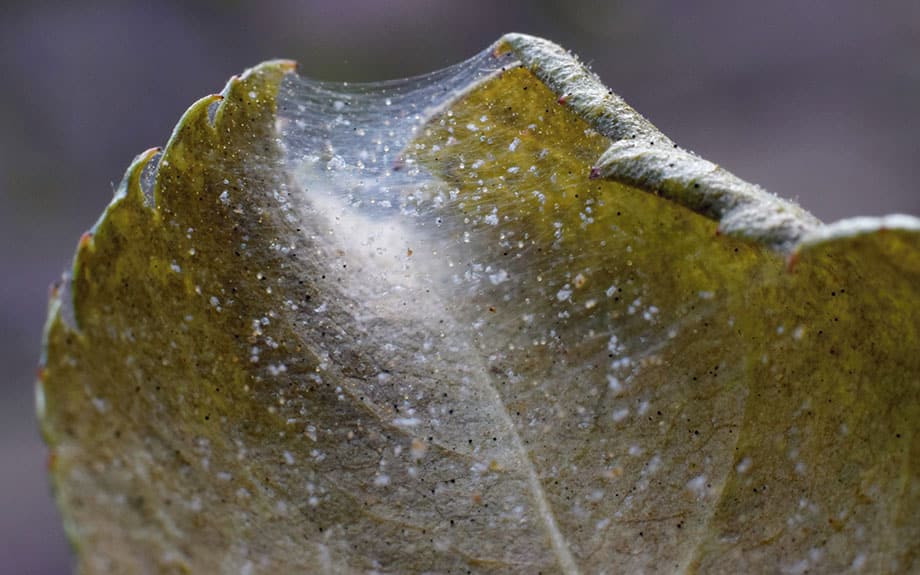
In a severe spider mite infestation, you’ll see webbing, as well as living and dead spider mites.
Plants Targeted by Spider Mites
Because there are so many species of spider mites in northern Virginia, they affect too many plant species to count. However, familiar shrubs and trees damaged by spider mites include:
- Arborvitae
- Azalea
- Boxwood
- Camellia
- Elm
- Fir
- Fruit trees
- Garden vegetables
- Hemlock
- Hollies
- Hollyhock
- Honeylocust
- Houseplants and greenhouse plants
- Juniper
- Laurel
- Linden
- Oak
- Phlox
- Primrose
- Rhododendron
- Roses
- Spruce
- Willow
Identifying Spider Mite Damage
Spider mites use their sharp, needle-like mouthparts (called stylets) to rasp and scrape the surface of leaves so they can suck out sap. This damages and kills plant cells, resulting in the recognizable stippled, scarred leaf surfaces that indicate spider mite infestation.
As more spider mites feed and the longer they feed, larger areas of the leaves’ upper surface die. Severely damaged leaves may look yellowed, bronzed, or bleached.
In a severe infestation, the plant loses leaves, declines, and may even die.
Because spider mite damage is often seen during hot, dry weather, it’s often confused with heat stress or the effects of drought. If you’re not certain if the damage you’re seeing is caused by heat/drought stress or by spider mites, call your arborist for a professional inspection.
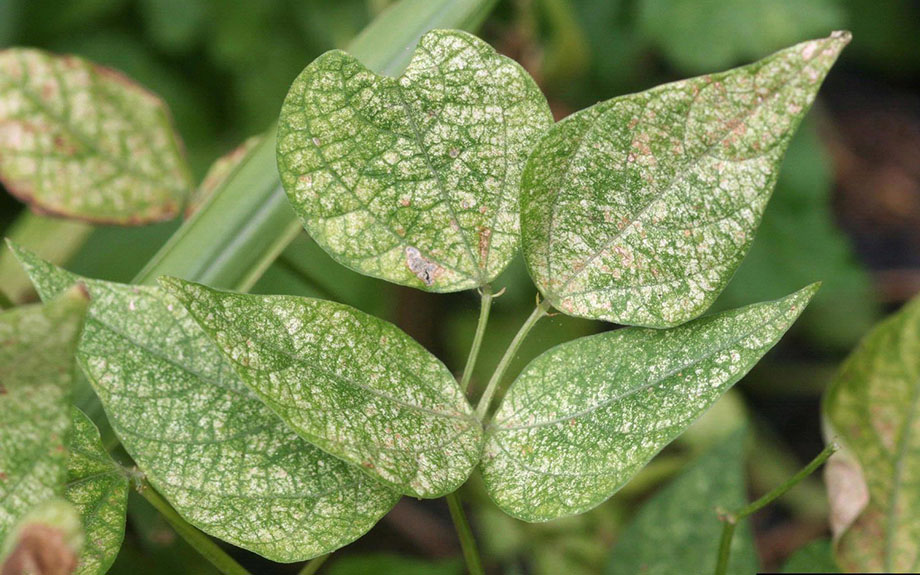
Leaf stippling and bleaching is a typical sign of spider mite infestation. Image by Whitney Cranshaw, Colorado State University, Bugwood.org
How to Spot Spider Mites
During the growing season, and especially during hot, dry weather, check your plants for spider mites every week or two. An easy way to do this is to shake an affected leaf over a sheet of white paper. If you see tiny colored dots moving around on the paper, your plant has spider mites. And if you have a magnifying glass (or a zoom on your camera), you’ll see that the adults look spider-like, with 8 legs (juveniles only have 6 legs).
Another sign to look for is fine, silk webbing on leaves and branches. Although they’re not spiders, spider mites do spin webs (which, not surprisingly, is how they got their name).
Timing
Some spider mite species overwinter as adults in soil, on the undersides of leaves, or in crevices on host trees or shrubs. Others spend winter as eggs and will hatch in early spring.
After hatching, spider mites mature within a month and start breeding. Many generations may be created within one growing season, leading to explosive population growth.
The worst damage from spider mite feeding is usually observed during the hotter summer months.
Spider Mite Control Options
Homeowners often inadvertently make spider mite infestations worse by trying to control them with insecticide sprays. Unfortunately, because they are not insects, conventional insecticides don’t work on spider mites but do kill off their natural predators, such as ladybugs, big-eyed bugs, minute pirate bugs, and predatory thrips or mites.
The end result is an explosion in the number of spider mites, with ensuing damage to their preferred plant targets.
Using Water to Control Spider Mites
Spider mites thrive in hot, dry conditions – the same conditions that stress plants and make them more vulnerable to spider mite damage. One way to address that is to water plants regularly and spray the leaves with a strong jet of water. This knocks adult spider mites, eggs, and larvae off the plant and quickly reduces the population. It also ruins their webbing, leaving them more vulnerable to predators. Be sure to get good coverage of the lower surface of the leaves. On conifers, thoroughly wash down the entire tree.
Using Chemicals to Control Spider Mites
When hosing of your plants isn’t practical or effective, the next option is to use a horticultural miticide – a pesticide that’s specifically developed for spider mite control. These pesticides usually don’t affect the eggs, so they’ll need to be reapplied every 10 to 14 days until the population is under control.
Insecticidal soap can also be sprayed on plants in summer, although it’s best used for smaller plants.
As part of our Tree Health Management programs, we use a special treatment that’s injected directly into the soil around infested trees and lasts 30 to 45 days (so it doesn’t need to be reapplied every 10-14 days). It also allows us to inject a lot of water into the root zone at the same time, helping keep trees hydrated so they’re better able to fend off spider mite attacks. Between the two, trees improve quickly.
Dormant oil sprays can be used to control mite and egg populations in winter or in early spring before growth begins. This is particularly helpful for species that feed during cooler weather, such as those that infest conifers and broad-leaved evergreens.
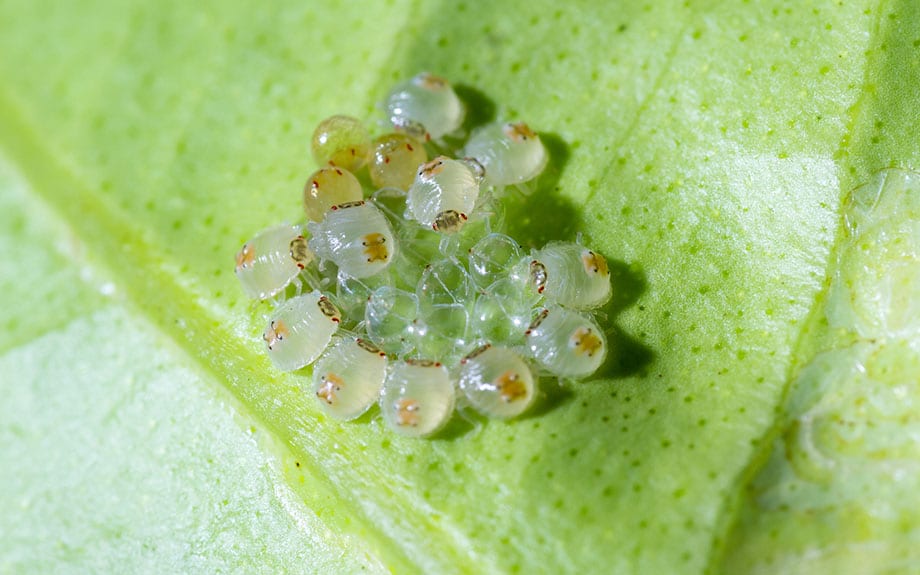
Newly-hatched spider mites on the underside of a leaf are so tiny that they’re difficult to spot.
Preventing Spider Mite Infestation
The best way to keep spider mites away is to keep your plants consistently watered during dry weather. Not only will healthy plants be better able to fend off attacks, but spider mites tend to avoid moist conditions.
Spider mites also like tender new growth so keep fertilization to a minimum during the hotter months, especially synthetic fertilizers with high nitrogen levels.
When practical (such as in the vegetable garden), cover plants with floating row covers and spray with insecticidal soap to keep spider mites under control.
Because spider mites can overwinter in fallen leaves, weeds, and other debris, remove them during your fall yard cleanup if you’ve experienced a significant spider mite infestation.
Be Vigilant
Spider mites may be tiny but they have a big impact on the health and appearance of your landscape. If you notice signs of infestation, take action quickly! And don’t forget to water plants thoroughly during summer (washing off leaves can also be helpful).
Give Us a Call at 703-402-9366
If you'd like help with your trees or landscape, have any questions, or would like to schedule an appointment with one of our Certified Arborists, please give us a call. We'd love to hear from you!

